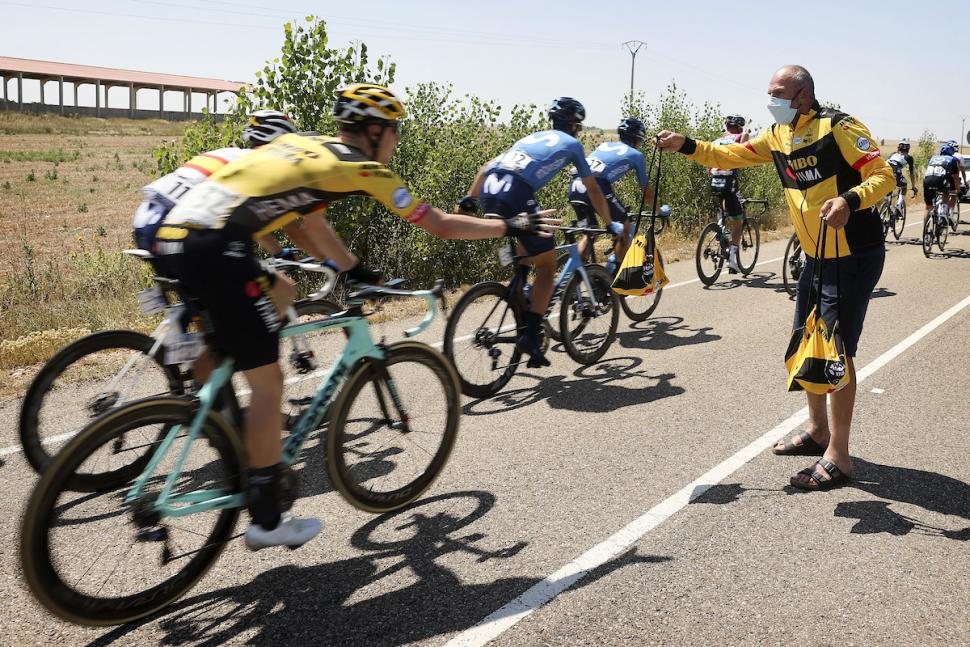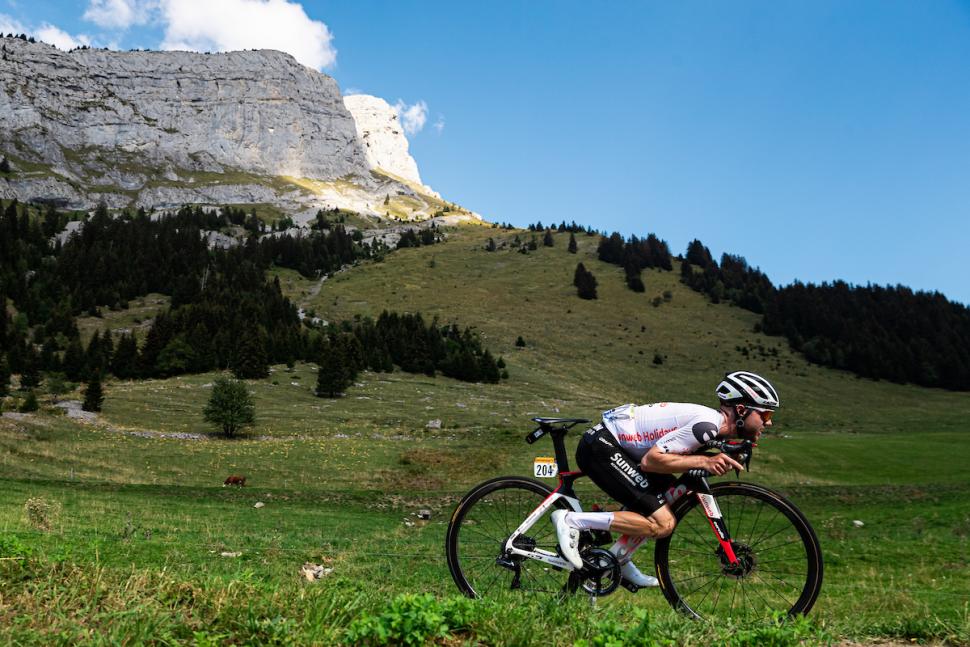- News
- Reviews
- Bikes
- Components
- Bar tape & grips
- Bottom brackets
- Brake & gear cables
- Brake & STI levers
- Brake pads & spares
- Brakes
- Cassettes & freewheels
- Chains
- Chainsets & chainrings
- Derailleurs - front
- Derailleurs - rear
- Forks
- Gear levers & shifters
- Groupsets
- Handlebars & extensions
- Headsets
- Hubs
- Inner tubes
- Pedals
- Quick releases & skewers
- Saddles
- Seatposts
- Stems
- Wheels
- Tyres
- Tubeless valves
- Accessories
- Accessories - misc
- Computer mounts
- Bags
- Bar ends
- Bike bags & cases
- Bottle cages
- Bottles
- Cameras
- Car racks
- Child seats
- Computers
- Glasses
- GPS units
- Helmets
- Lights - front
- Lights - rear
- Lights - sets
- Locks
- Mirrors
- Mudguards
- Racks
- Pumps & CO2 inflators
- Puncture kits
- Reflectives
- Smart watches
- Stands and racks
- Trailers
- Clothing
- Health, fitness and nutrition
- Tools and workshop
- Miscellaneous
- Buyers Guides
- Features
- Forum
- Recommends
- Podcast
feature
 mark hirschi no top tube descending - original image from SWPix
mark hirschi no top tube descending - original image from SWPixGet to grips with the new UCI rules: changes to look out for in this year’s Tour de France
We can’t say that the UCI’s rule book is the most entertaining read... but they do seem keen on constantly changing it, so if you’re about to ride (or watch) the Tour de France, it’s probably worth a flick through. Here are the rules that are new for the 2021 race.
> Check out the 2021 Tour de France race bikes
Bike racing is, in essence, rather simple. You all start at point A, follow a predetermined route to point B and the first one there gets a yellow top; however, look a little deeper, or simply take a look at the UCI’s list of penalties for each stage, and you’ll see riders and teams racking up sizeable fines issued in Swiss francs that we’d bet go directly into the UCI’s Christmas party fund. What are all of these fines for? Why can’t the riders just follow the rules? And which ones are new for 2021?
Feeding time at the zoo
Special attention needs to be paid by the soigneurs as to where they’re standing when they hand out the last bottle of the day. The UCI has always stipulated a final feed point, which is at about the 20km to go mark on a normal stage. Listen to the TV commentary and Sean Kelly will be talking about 'the bar closing' - this is what he’s on about.
On mountain stages, this can be changed to around 10km to go, as that 10km is going to take the riders significantly longer to complete. In extremely hot weather, the rule can be adjusted again.
The UCI has been hot on handing out the fines lately for illegal feeding, and while the small monetary fine is no issue for a Tour de France team, if one of the GC leaders gets caught taking a bottle once the bar has closed, the time penalty that accompanies the fine is a much bigger issue.
Want a bottle? Don’t go to the start
For many fans, no matter how big or small of a kid you are, getting a free bottle that has been jettisoned by a pro cyclist that was moving too quickly for you to actually identify is one of the best things about going to a bike race.
Sure, you could head to Decathlon and pick up a nice clean one for about €5 but where’s the romance in that? The UCI is fed up with riders providing this small token to fans, so they’ve banned this evil practice until the final 50km of each stage.
This is actually a relaxing of the original rule change with was brought in on - you couldn’t make it up - April fool’s day! Riders caught throwing bottles to fans in the Tour of Flanders were faced with disqualification from the race. It was laughable and after the world of cycling voiced its displeasure, the UCI eventually relaxed the rule.
There are now dedicated littler zones every 30-40km where riders can get rid of any litter without punishment. This one is actually quite sensible, as it gives riders a place to throw their empty wrappers (they get through a lot) and you’ve rightly got a sport that looks cleaner, along with a far easier cleanup job once the race has passed through.
Puppy paws and Pantani
Marc Hirschi and Matej Mohoric will be rather sad as the UCI has this year decided to clamp down on how riders ride their bikes.
Hirschi used the 'puppy paws' position - where the rider rests their forearms on the tops of the bar to reduce their frontal area - to great effect in last year’s Tour, taking an impressive solo victory on stage 12.
But wait! The fledgling component brand Speeco caused a stir when they launched aero-optimised road handlebars back in December, which would in theory provide riders with a legal way to replicate the position... not so fast, as the UCI recently disqualified Jan-Willem van Schip from stage three of Baloise Belgium Tour after the Dutch pro used the Aero Breakaway Bar. The UCI clarified that "using the forearms as a point of support on the handlebar is prohibited except in time trials”, even if the riders hands do have something to grab onto.
Mohoric was the original top tube descender, and while there have been next to no crashes in pro races due to riders adopting this position, the UCI has banned it anyway, saying that they don’t want younger riders copying it. Instead the kids can do something safe, such as downhill mountain biking...
The top tube position was immensely popular, giving a distinct advantage to attacking riders, so it’s sad to see it go. If you’re a rider that has dashed away from the peloton then don’t think that you can do anything other than hold onto the bar and sit on the saddle. Even the Pantani position, which put the rider’s derrière perilously close to the rear tyre, has been outlawed.
The riders should know by now, but watch out for animated gesticulation should a commissaire spot a rider spending just a second perched on the top tube.
Barriers
The Tour de France is a rather large race and as a result, it attracts thousands of spectators to the key points on every stage. Barriers are required in the finish area of every stage and they do a good job of keeping fans out of the road. For mountain top finishes, the minimum requirement is 300m and a flat finish needs 500m of barriers, though in the Tour de France a sprint finish barrier section is often longer.
For 2021, there is a key phrase that has been applied to the rules concerning barriers and that is that they must be continuous and “firmly attached to each other.” This is important because it aims to prevent such catastrophic injuries as those suffered by Fabio Jakobson when he was sent into the barriers at around 80kph during the Tour of Poland.
Thankfully the barriers used in the Tour de France sprint finishes are now very good and despite several crashes each year, the barriers have remained firmly in place.
This isn’t the final chapter in the barrier story. There’s a study set to be carried out that aims to establish a set of standards for the barriers used in sprint finishes. These new standards will enter into force in 2022. For extra barrier nerdiness, check out Boplan’s design (above) that was used in this year's Tour of Flanders.
Pinch points
Remember when a Yates twin was taken out by a rapidly-deflating flamme rouge arch? Or how about all of those crashes that happen when the road suddenly narrows because of the 40km to go sign? That is hopefully going to be a thing of the past. While the arches are still allowed, there are new measures to make things safer.
Firstly, where an arch narrows the road, barriers must funnel the peloton gradually for at least 100m before the pinch. While that’s a decent distance when you’re pootling along, at leadout speed, 100m goes by rather quickly.
Where the road is far too wide, or an arch cannot be installed, an alternative, such as a split arch will be used. It’s a small measure but hopefully, it will prevent some of those silly crashes that often take out one of the pre-race favourites.
Got those? Good. They just add to the other 312 pages of regulations to learn. No wonder the fines tot up during a three-week race!
Original main image from SWpix







Id say most dont even bother going there and ironically, will be collected by and transported to them by deliveroo. Many of which are on e-bikes. ...
Theres only 2 things I can't stand in this world. People who are intolerant of other peoples cultures...and the dutch.
I know the Limes made a mess, but my inner self sees a bicycle commuter porn image.
The 6 is an S in PNP-speak, I think. ...
Thats if you believe that a slightly bigger bearing surface translates in any meaningful way to "pedaling stiffness" which to my mind is the...
Everyone carrying more / brighter searchlights will fix things? Perhaps it helps sometimes, but I think this leads to other issues. We're already...
Lake's naming and sizing: never knowingly comprehensible. Good shoes, baffling range.
Yeah, I doubt if Arron Banks would be happy visiting "little Somalia" (as he referred to Bristol) and certainly I don't think Bristol's residents...
Not enough, evidently.
It could be used as a reliable comparison without any calculations.